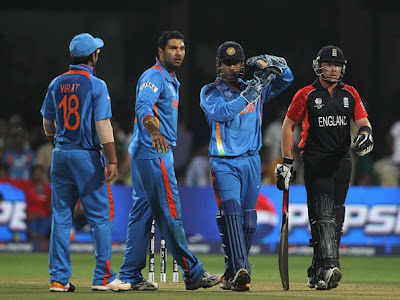The title has made it obvious what this is about. I was confused for a moment when Billy Bowden signaled Ian Bell not out on that ball off Yuvraj Singh. I thought that Billy must have made a mistake and will raise his crooked finger soon... because Bell was already walking off. Then he called Bell back and the Indian fielders surrounded him to ask whether it was something they didn't know about or whether his head was not in his place! It turned out to be the latter...
I attribute that one moment as the reason why England were able to tie the game that was India's for the taking. Andrew Strauss batted like a dream... but a chase such as that is possible only with partnerships. And Ian Bell was his partner in what could have been a match-clinching partnership, which shouldn't have been so long but for Billy Bowden.
The 2.5 metre rule of UDRS is as ridiculous as any rule I have come across. And I don't get it why the law makers did not see how absurd it is when they framed it. Do they not run simulations to check whether the rule has any bad effects? In this case, the 2.5 metre rule only has the wrong effects. Here's why...
If that rule is implemented the way it was implemented today, there is no point in asking for reviewing a leg before decision by a fielding captain when someone like Kevin Pietersen is batting. Because even if the ball pitches on middle (RED), impact is on middle (RED) and goes on to strike the middle of middle (RED), the decision will always have to be not out because the umpire's original decision was not out as Pietersen plays his game a long way in front of the stumps.
In short, the moment a batsman comes more than 2.5 metres from the stumps, the UDRS becomes redundant... because no matter how plumb it looks, the ground umpire's original Not Out call will stand. In a way, insertion of this clause of 2.5 metre in the UDRS rule seems to have changed the law of Leg Before Wicket itself. UDRS was introduced to assist with LBW decisions, not to change the law of LBW!
From what I understand, this 2.5 metre guideline has been inserted because the makers of this technology believe that if the ball has to travel more than 2.5 metres after impact, its ball projection accuracy reduces. Fair point. They have claimed that their technology is not perfect and I have no problem with that!
But they say that the accuracy reduces... it does not say that accuracy goes down to zero. In such a case as was played out today, where the ball was striking half way up between the middle and off... even if we consider that the path projection may not have been completely accurate, it seemed obvious that the ball would still have hit the stumps.
It might have been on the off stump or on the middle stump... it might have been a little higher or a little lower... but there was no way on earth that that particular ball would have done anything but hit the stumps had Ian Bell not existed. In such scenarios, it pains me to see that the umpires (both ground umpire and the third umpire) do not make use of their common sense and grey cells to make the decision. This one was a very daft piece of decision-making on display today.
The purpose of UDRS is to implement a technology that assists the umpires... and not replaces them! If the 2.5 metre guideline is going to be a decisive rule, then as I said earlier, for a batsman like Kevin Pietersen, UDRS becomes redundant. However, had the 2.5 metre guideline been used as a suggestive rule, then not only would Ian Bell have been dismissed and the result of this match possibly different, but the UDRS would also have has a lot more credibility. It would certainly need some now!
Can Karun Nair turn wishes into runs
22 hours ago


















